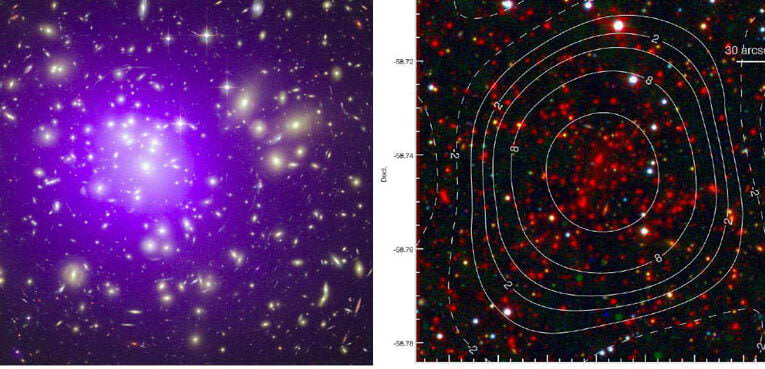Clusters of stars, known as globular clusters, are found not only in our own galaxy but also in other galaxies. The spatial arrangement of these clusters in spiral galaxies is similar to that in our Milky Way. However, there is a noteworthy distinction in the distribution pattern of the Galactic clusters compared to those in the Magellanic Clouds. Unlike our Galaxy, the Magellanic Clouds exhibit the presence of both old and young clusters, specifically the blue globular clusters.
The occurrence of young globular clusters in the Magellanic Clouds suggests that the formation of such clusters is either ongoing or has recently concluded in these galaxies. On the other hand, in our Milky Way, there seems to be a lack of young globular clusters akin to the blue clusters observed in the Magellanic Clouds. Consequently, it can be inferred that the epoch of globular cluster formation in our galaxy ceased a significant amount of time ago.
Globular clusters undergo a process of dynamic evolution, gradually losing stars over time. Consequently, when examining high-quality optical images of these clusters, we often observe evidence of tidal interaction with the Galaxy in the form of extended deformations, known as tidal tails. Additionally, our observations reveal an increase in stellar density along the Galactic orbits of these clusters, indicating the presence of lost stars. Certain clusters, whose orbits bring them close to the galactic center, are particularly susceptible to destruction due to the tidal influence exerted by the center. As a result, the galactic orbits of these clusters also experience changes as a result of dynamical friction.
Galactic clusters are systems of galaxies that are bound together by gravity. They are some of the largest structures in the universe, with sizes that can reach up to 10^8 light-years.
These clusters can be classified into two main types:
- Regular clusters have a spherical shape and are dominated by elliptical and lenticular galaxies. They have a well-defined central region, and giant elliptical galaxies are usually found at their centers. An example of a regular cluster is the Veronica’s Hair cluster.
- Irregular clusters, on the other hand, lack a specific shape and have fewer galaxies compared to regular clusters. Spiral galaxies are more common in these clusters. The Virgo cluster is an example of an irregular cluster.
The masses of these clusters can range from 10^13 to 10^15 solar masses.
Related Articles
Wikimedia Foundation. 2010.
Helpful
Discover the definition of “Galaxy cluster” in other dictionaries:
A GALACTIC cluster is a collection of galaxies that are relatively close to each other and are held together by gravitational forces. There are over 3000 known galaxy clusters, with a range of tens to thousands of members. One example of a galaxy cluster is… … … Big Encyclopedic Dictionary
A galaxy cluster is a group of galaxies that are bound together by gravity. Galaxies in space tend to cluster together due to their mutual gravitational attraction. The distribution of galaxies in space is not uniform: they have a tendency to cluster together at distances of… … Astronomical Dictionary
galaxy cluster – a group of galaxies that are close to each other and held together by gravity. There are more than 3000 known galaxy clusters, ranging in size from a few tens to several thousand members. One example of a galaxy cluster is the Local Group of Galaxies… … … Encyclopedic Dictionary
galaxy cluster – a collection of galaxies that are relatively close to each other and held together in a single system by gravitational forces. There are more than 3000 known galaxy clusters, with varying numbers of members. One example of a galaxy cluster is… … … Fizikos terminų žodynas
GALACTIC COLLECTION – a group of galaxies that are relatively close to each other and connected in a single system by gravitational forces. There are more than 3000 known galaxy clusters, with member counts ranging from tens to thousands. One example of a galaxy cluster is, apparently, the Local Group of Galaxies… … … Natural History. Encyclopedic Dictionary
Furnace cluster – A cluster of galaxies… … … Wikipedia
Naugol cluster – A group of galaxies in close proximity to each other. This cluster is well-documented and has been extensively studied. It is known for its unique characteristics and has been the subject of numerous scientific investigations. For more information, please refer to the Wikipedia page on the Naugol cluster.
Veronica’s Hair Cluster – An intriguing cluster of galaxies that is often referred to by other names such as the Coma Cluster or Abell 1656. This cluster is particularly notable for its appearance in ultraviolet and visible light, which has provided valuable insights into its composition and structure. To learn more about this fascinating cluster, you can visit the Wikipedia page dedicated to Veronica’s Hair Cluster.
Virgo cluster – A well-studied cluster of galaxies located at a distance of approximately 15 to 22 megaparsecs from Earth. This cluster is of great interest to astronomers due to its close proximity and the wealth of information it provides about galaxy formation and evolution. To explore further, you can consult the Wikipedia page on the Virgo cluster.
Phoenix Cluster – This galaxy cluster, also known as the Rashid Syunyaev et al. cluster, is distinct from the Phoenix constellation. It has a fascinating history of exploration and was first discovered by a team of scientists. For more detailed information about the Phoenix Cluster, including observed data and designations, please visit the Wikipedia page dedicated to this cluster.
* is compressed by the force of gravity. As it compresses, it fractures into pieces from which galaxies subsequently emerge. From this perspective, galaxy clusters are expected to be stable systems where the kinetic energy of the galaxies is
less than
their gravitational binding energy. According to Virial’s theorem (paragraph 1.3), the kinetic energy of a gravitationally bound system is half of its potential energy. In the second quarter of the 20th century, astronomers applied Virial’s theorem to galaxy clusters and obtained an intriguing finding. A significant portion of the clusters were found to be gravitationally unstable systems. The velocities of the galaxies within the clusters are so high that the clusters are projected to disperse into separate galaxies in the future. From this, only two completely opposite conclusions could be drawn.
1. According to V. Hambardzumyan [12], clusters of galaxies are systems that lack gravitational stability, thus disproving the initial hypothesis of galaxy formation.
2. The current consensus is that the first scenario of galaxy formation is accurate, indicating that galaxy clusters possess an invisible mass that guarantees their stability.
Let’s clarify something here. The presence of gravitationally bound galaxy clusters and galaxy groups does not go against the second theory of galaxy formation, which suggests that galaxy clusters formed through the explosions of incredibly dense massive objects. According to this perspective, clusters can be both stable and unstable due to gravity. However, the existence of even one unstable galaxy cluster goes against the widely accepted theory. This is why contemporary theoretical astronomers strongly believe that galaxy clusters contain hidden mass. They simply assume that all clusters are stable systems and calculate the quantity of hidden mass within them.
Observational astronomer S. Mitton does not show support for any of the current theories on the formation of galaxies and therefore does not make any conclusions based on astronomical observations. However, it is necessary to draw a conclusion. The presence of gravitationally unstable, disintegrating galaxy clusters directly contradicts the widely accepted initial scenario of galaxy formation. This contradiction becomes even more pronounced when considering super clusters instead of just clusters.
Let’s consider the instance of the Local Supergroup of galaxies. This remarkable structure comprises numerous clusters and groups of galaxies. Its span measures approximately 100 million light-years, while its depth is estimated at around 60 million light-years [146]. Situated in the constellation of Virgo, at a distance of 50 million light-years from us, lies a colossal cluster of galaxies at the heart of our Local Group. Thus, our Local Group of galaxies occupies a position on the outermost periphery of the supergroup.
What are the origins of this galactic supergroup?
Could it be possible that the formation of our supergroup is a result of the compression of rarefied gas masses due to gravity? Unfortunately, this is not the case, as our supergroup is actually a gravitationally unstable system. However, is it possible that there is a massive hidden mass within the super cluster that contributes to its gravitational stability, similar to the hypothesis for galaxy clusters? The answer to this question is no. The reason being that in the case of our super cluster, a hidden mass would be completely ineffective. This is because our super cluster is not only gravitationally unstable, but it is also expanding.
By the end of the 20th century, astronomers were finally able to fully comprehend the significance of the expansion of the Local Supergroup. This remarkable discovery holds immense importance in unraveling the mysteries surrounding the evolution of the Universe. In Chapter 7, we will delve into this phenomenon, along with other fascinating astronomical findings that captivate our curiosity.
- The Universe
- Observable Universe
- Super clusters of galaxies Large-scale structure of the Universe
- Galactic filaments
- Voids
- Hubble bubble
- Relict radiation
- Hidden Mass
- Dark matter
- Dark energy
- Major stages in the evolution of the Universe
- Age of the Universe
- Formation of galaxies
- Expansion of the Universe
- Cosmological redshift
- Hubble’s Law
- Accelerated expansion of the Universe
- Nucleosynthesis
- Gravitational instability
- Cosmological principle
- Cosmological Models
- Cosmological Singularity
- Big Bang
- De Sitter model
- Hot Universe Model
- Cosmic inflation
- The equation of the universe according to Friedman’s theory
- The corresponding distance
- The model of Lambda-CDM
- The equation of state of the universe
- The density required for the universe to continue expanding
The universe within 1 billion light-years (307 Mparsecs) is depicted, showing the closest supercollisions. This includes a galaxy supergroup, which consists of numerous groups of galaxies and galaxy clusters within the large-scale structure of the universe.
Galaxies in our Universe are not evenly distributed – the majority of them are grouped together in clusters and groups that range in size from a few dozen to several thousand galaxies. These clusters, along with isolated galaxies, come together to form even larger structures known as superclusters. Superclusters consist of anywhere from two to twenty galaxy clusters and can be found in galactic filaments or at the intersections of these filaments. The size of superclusters can span hundreds of millions of light-years. These superclusters are so massive that they are not held together by gravity and instead are part of the expanding universe according to Hubble’s Law. It is estimated that there are approximately 100 superclusters within a billion light-years [1].
Previous suggestions indicated that superclusters are the largest formations in the Universe. However, recent discoveries have led to the belief that superclusters are actually part of immense walls, otherwise known as filaments, that can span over a billion light-years in length, accounting for more than 5% of the observable Universe. Through the observation of superclusters and larger structures in the present, we are able to gain insight into the state of the Universe during the time of their initial formation. The rotational axes of galaxies within superclusters also provide valuable information regarding the early development of galaxies in the history of the Universe.
Due to their vast sizes, the study of superclusters heavily relies on a substantial amount of observational data, primarily consisting of the radial velocities of galaxies.
Closest superclusters
The supergroup nearest to the Virgo Superscale is this supergroup
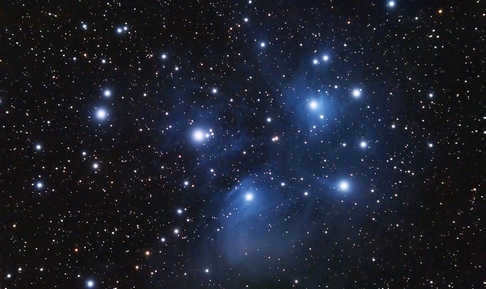
A dispersed star cluster refers to a collection of stars (ranging in quantity from tens to thousands) that share a similar age and originate from a single molecular cloud. These clusters are held together by exceptionally feeble gravitational forces, making them susceptible to disruption from external factors such as the galactic core or other clusters. The lifespan of these clusters is estimated to be several hundred million years.
Distribution
In our galaxy, there is a vast number of scattered star clusters, with over 1100 known clusters and potentially ten times more yet to be discovered. These clusters are not evenly distributed throughout the galaxy. In spiral galaxies, they are primarily found along the spiral arms. This is due to the high density of gas in those regions, which promotes more active star formation processes.
In irregular galaxies, scattered star clusters can be found anywhere, but their concentration is higher in areas with greater gas density. However, in elliptical galaxies, no such clusters have been observed. This absence can be attributed to the lack of ongoing star formation in these regions.
The distribution of scattered star clusters in our galaxy is also influenced by their age. Older clusters tend to be located farther from the galactic center and the galactic plane.
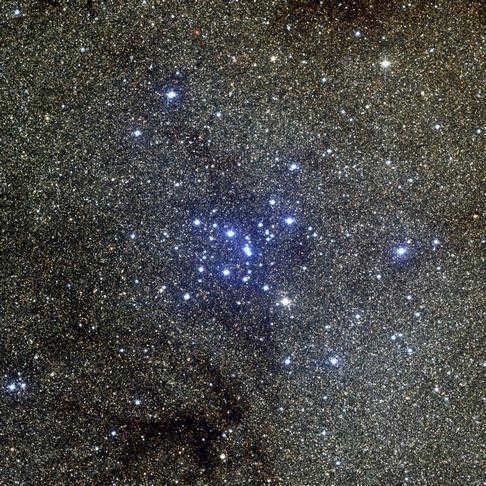
Structure
Scattered star clusters come in a variety of sizes, ranging from small groups of a few stars to large agglomerations of several thousand stars. They are characterized by a dense core that is easily visible, surrounded by a less dense outer region.
The core typically has a diameter of 3 to 4 light-years, while the outer region extends up to 40 light-years. In the central region, the density of stars is typically around 1.5 stars per cubic light-year. In comparison, the density of stars near the Sun is approximately 0.003 stars per cubic light-year.
The composition of scattered star clusters is determined by their age. Since most scattered star clusters reach the end of their life cycle through decay, they are predominantly composed of hot, blue stars. However, older clusters tend to have a higher proportion of yellow stars.
Scattered star clusters are typically categorized using the Trumpler classification or scheme proposed by Robert Trumpler in 1930. This classification system consists of three parts:
- The first part is a Roman numeral ranging from I to IV, which indicates the concentration of the star cluster and its distinctiveness from the surrounding species.
- The second part is an Arabic numeral (1, 2, or 3) that represents the brightness of the stars within the cluster.
- The third part is a Latin letter (p, m, or r) that signifies the content of stars in the cluster, with “p” indicating low content, “m” indicating medium content, and “r” indicating high content. If the cluster is located within a nebula, the letter “n” is added at the end.
Based on the classification mentioned above, the Pleiades star cluster is identified as I3rn – a highly dense cluster with a high number of stars, situated within a nebula. Meanwhile, the Hyades star cluster, which is more spread out, falls under the category of II3m.
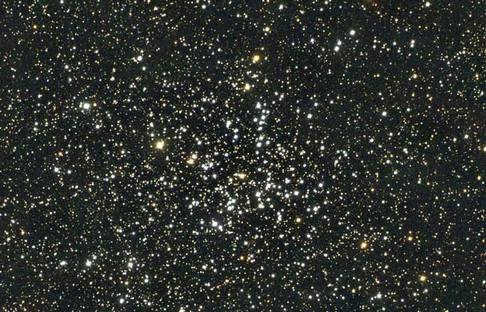
If you enjoyed this post, feel free to share it
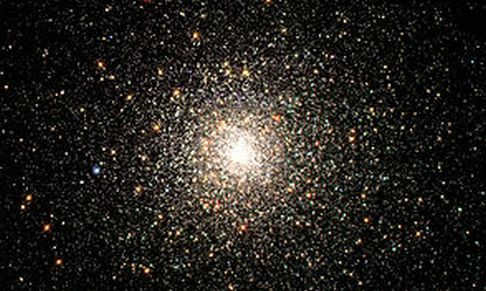
Globular star clusters are clusters of stars that are tightly bound together by gravity and contain a large number of stars. They orbit around the center of a galaxy as companions. In contrast to scattered star clusters, globular clusters are much older and have a greater number of stars. The main distinction is their symmetrical spherical shape and the increasing number of stars towards the center of the cluster. A typical globular cluster is estimated to be 12.7 billion years old (although relatively young clusters have been discovered in galaxies like the Large Magellanic Cloud).
Globular clusters are a common sight in our galaxy. As of 2011, there have been 157 discoveries of these clusters in the Milky Way, with about 20 more being considered as potential candidates. However, larger galaxies have even more of them. For instance, the Andromeda Nebula (M31) is estimated to have around 500 globular clusters, while the elliptical galaxy M87 is believed to contain a staggering 13,000 of these celestial objects!
In contrast to scattered clusters that are found in the galactic disk, globular clusters are primarily located in the halo. They revolve around the galactic center in highly elongated orbits, reaching velocities of approximately 200 km/s and completing a full orbit in a period of 10^8 to 10^9 years.
Globular star clusters are typically made up of old stars and have a low metallicity. They have a high concentration of stars, with around 0.4 stars per parsec³ on average, and a higher density of 100-1000 stars per parsec³ in the center. The average distance between stars within these clusters is estimated to be 3-4.6 trillion kilometers, which is 700-7000 times larger than the distance between stars near the Sun. The diameters of globular star clusters are believed to be between 20-60 parsecs, and they have masses ranging from 10⁴ to 10⁶ times that of our Sun.
Due to their high stellar concentration, globular clusters often experience collisions. As a result, these “star clusters” contain a variety of exotic star types, including blue stragglers, low-mass X-ray double stars, and millisecond pulsars.
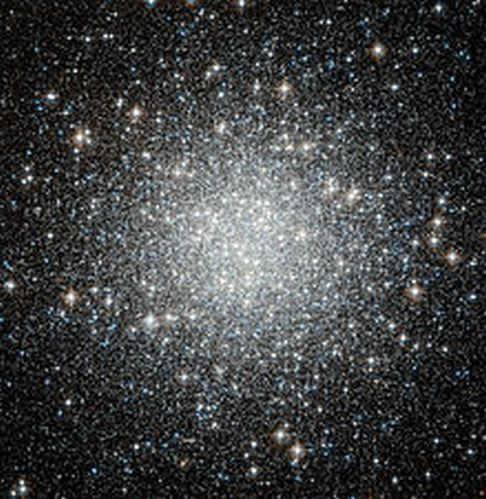
Since the Hubble telescope was introduced, there has been speculation among scientists about the presence of intermediate-mass black holes in the globular star clusters M15 and Mayall II in the M31 galaxy. Despite some skepticism surrounding this theory, with claims that the clusters may contain white dwarfs and neutron stars instead of black holes, the possibility remains of these heavy objects being present at the center of these clusters.
The issue of the presence of planetary systems in globular clusters is not the least important. According to theory, any planet within such a setting could only survive for a maximum of 100 million years due to intense gravitational disturbances caused by other stars, particularly in the cluster’s core. However, a planetary system has indeed been found around PSR B1620-26, a pulsar located in the M4 cluster. This peculiar occurrence can be attributed to the formation of the planetary system occurring after the birth of the pulsar.
Sorting
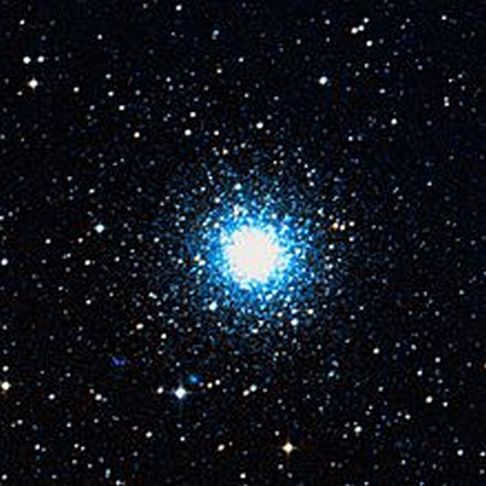
Peter Oosterhof, an astronomer hailing from the Netherlands, made a remarkable discovery indicating the existence of two distinct populations of globular clusters. Consequently, all globular star clusters were classified into two distinct groups now known as the Oosterhof groups. Interestingly, both groups exhibit faint spectral lines of metallic elements. However, the primary distinction lies in the fact that the spectral lines of the first group (OoI) are more pronounced compared to the second group (OoII), and the latter displays a slightly longer period in variable stars such as RR Lyrae.
Based on these observations, type I stars are referred to as “metal-rich,” while type II stars are referred to as “low-metal-rich.”
Furthermore, the distribution of these clusters within the galaxy also varies. OoI globular clusters are primarily located in the bulge region, while OoII clusters reside in the galactic halo.
Globular star clusters are truly celestial treasures that can captivate observers for extended periods, even when observed through an amateur telescope.
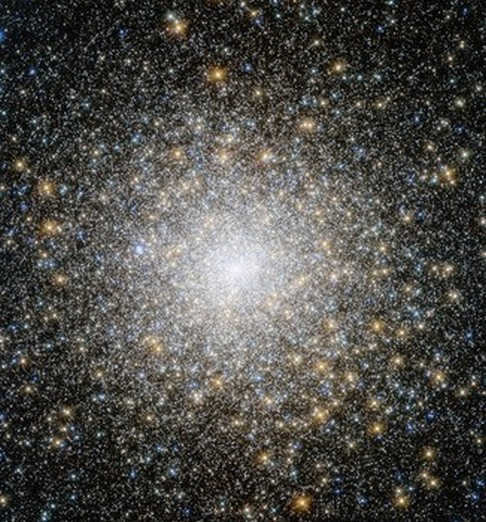
Feel free to distribute this article if you found it interesting
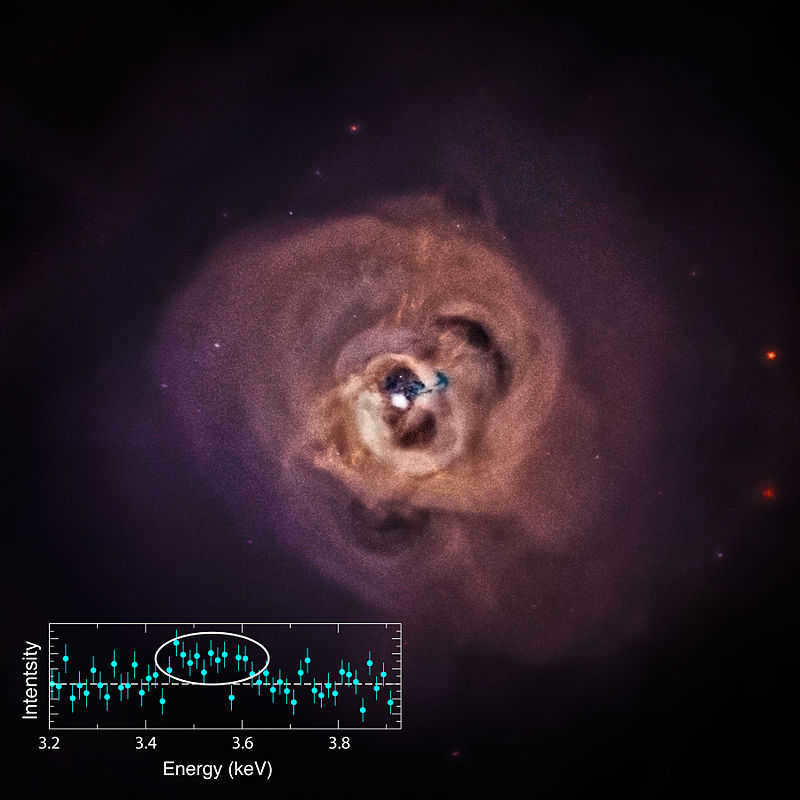
One of the most massive objects in the Universe, the Perseus cluster, can be seen in this Chandra telescope image. Its emission of radio waves is due to the presence of relativistic jets.
Clusters are formed when stars within galaxies come together and become gravitationally bound. A galaxy refers to a system consisting of stars, star clusters, interstellar gas and dust, dark matter, and planets, all held together by gravity.
Galaxies also come together to form clusters, which are groups of galaxies that are held together by gravity. A galaxy cluster can have a mass of 10^14 – 10^15 solar masses and contain anywhere from 100 to 1000 galaxies, as long as the mass of the galaxies within it falls between 10^6 – 10^13 solar masses. The Bautz-Morgan classification was created to categorize galaxy clusters based on their morphology.
One important aspect of galaxy clusters is the intercluster medium, which is made up of superheated plasma. This plasma consists mostly of ionized hydrogen and helium, and it emits X-rays because it is heated to temperatures between 10 and 100 MK. The majority of the baryonic matter in galaxy clusters is concentrated in this intercluster plasma. It is not entirely clear what causes this medium to become heated, but it is likely a combination of relativistic jets emitted by the central galaxies in the cluster and the interaction between atoms in the medium during galactic subcluster mergers. The galaxies themselves account for about 1% of the cluster’s mass, while the intercluster medium accounts for 9%. The remaining mass is made up of dark matter.
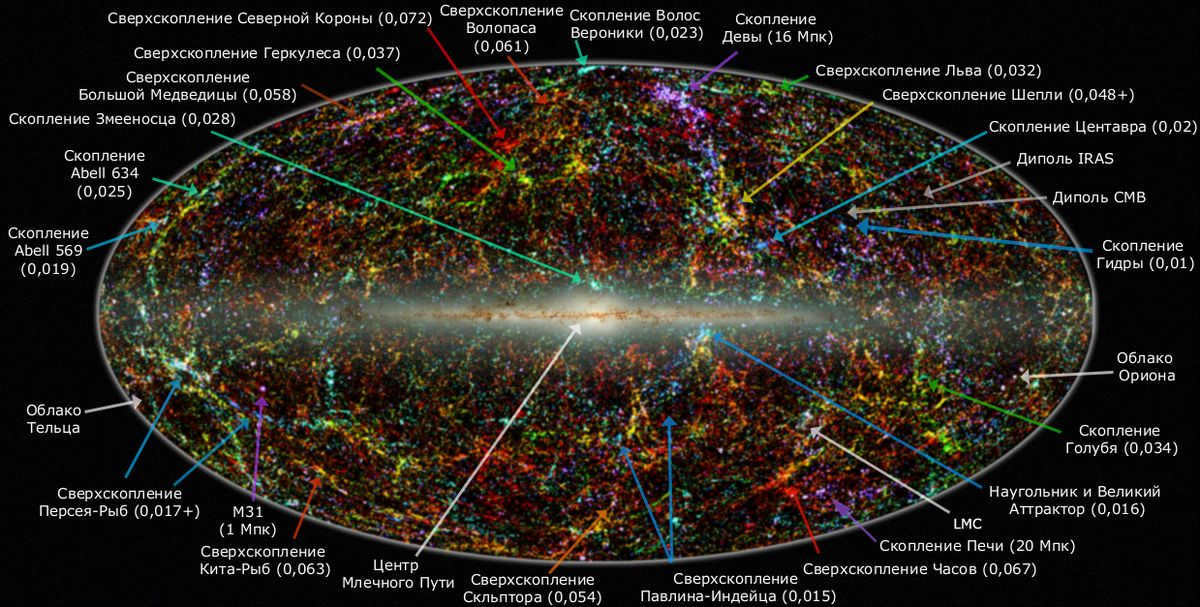
Galaxies and their clusters, in turn, create even bigger formations known as galactic filaments. These structures, often referred to as galactic walls, bear a resemblance to soap bubbles that enclose vast emptiness. In the realm of astronomy, this emptiness is known as a howdah. These massive “walls” span from 160 to 260 million light-years in length, making them the largest known structures in the Universe.
The Halo of the Galaxy
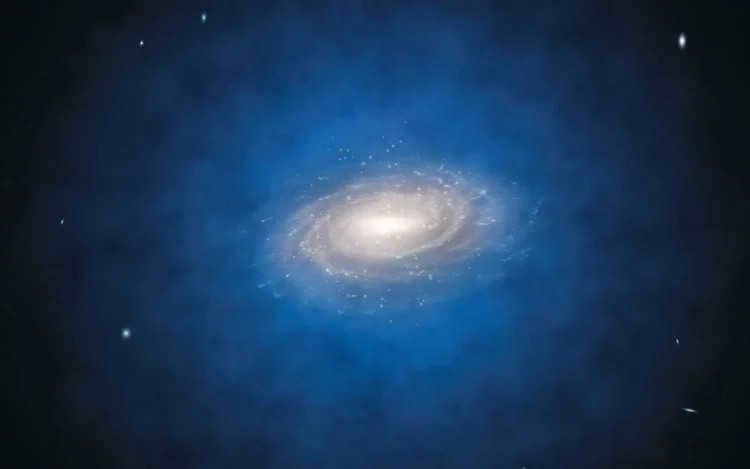
Galaxies are primarily composed of stars, and when observing a galaxy, stars are the most visible feature. However, the reach of a galaxy extends beyond just its stars, thanks to a component known as the halo. The halo has a roughly spherical shape and includes the stellar halo, the galactic corona, and the dark matter halo.
The stars that are easiest to observe are located closer to the center of the galaxy and in the surrounding regions. However, there are also stars located further towards the back of the galaxy. These stars are typically the oldest in the galaxy and may have been captured during mergers between the main galaxy and its galactic companions. These stars form the stellar halo of the galaxy.
The galactic corona refers to the hot ionized gas, or plasma, that surrounds a galaxy. Scientists believe that it is created by “galactic fountains” – streams of particles emitted by supernova explosions and their remnants.
Dark matter is present in every galaxy and extends far beyond its visible portion. While this dark matter halo cannot be directly observed, its existence can be inferred through indirect evidence, such as the gravitational effects on the motion of stars and gas, as well as the presence of gravitational lensing. Dark matter halos play a crucial role in the formation of galaxies – during the initial stages of this process, the temperature of normal matter is too high for it to gravitationally coalesce into bound objects. Therefore, the presence of dark matter structures is necessary to provide additional gravitational influence and allow galaxies to form.
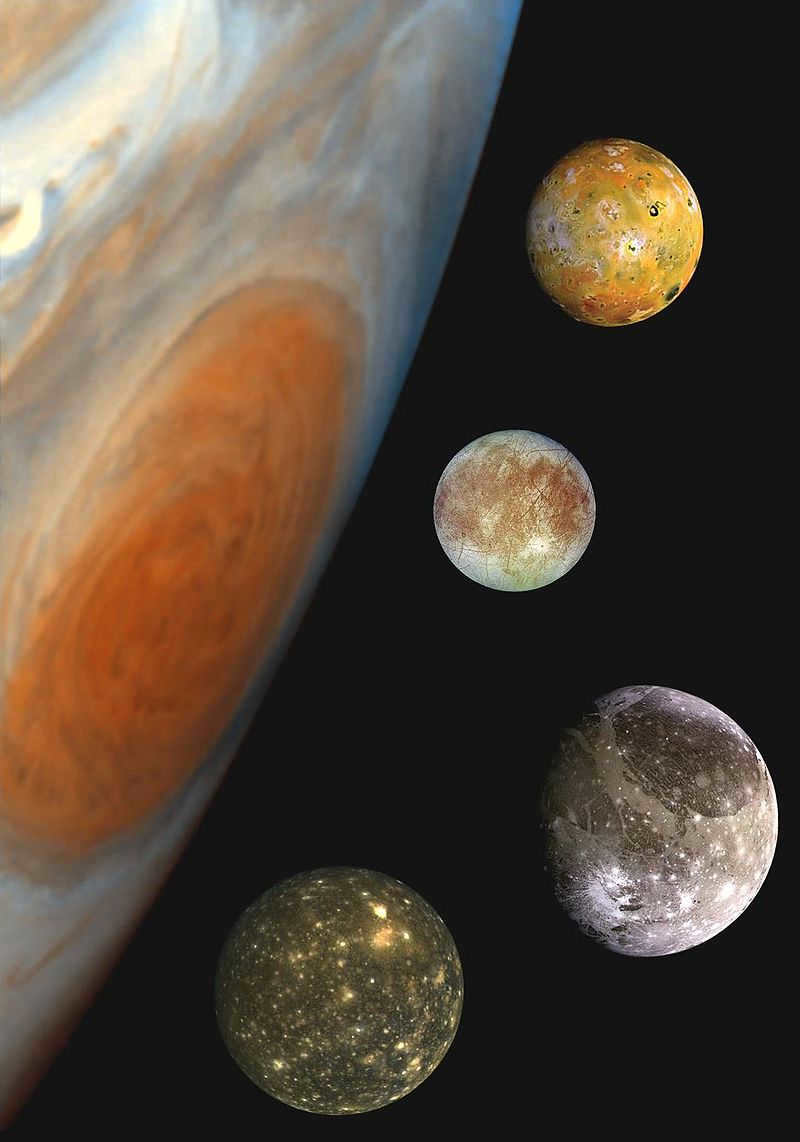
Galileo Galilei, born in 16th century Italy, is renowned as one of the most influential scientists in history. His extensive studies in physics, mechanics, astronomy, philosophy, and mathematics made a profound impact on the scientific community during his time. Galileo is especially known for his pioneering use of the telescope to observe celestial bodies.
In the year 1609-1610, Galileo made significant advancements to his telescope, increasing its magnification to 20x. It was during this time that he observed four celestial bodies near Jupiter in the sky. Initially, he believed them to be stars, but by the spring of 1610, he deduced that they were actually satellites orbiting Jupiter. These were the first satellites of a planet in the solar system, aside from the Moon, to be discovered by humankind.
These four satellites are the largest among Jupiter’s many satellites. There are currently 80 known satellites orbiting Jupiter.
Io is the Solar System’s fourth largest satellite, just a bit bigger than the Moon, and it’s also the most active geological entity in the entire Solar System. With over 400 active volcanoes and more than 100 mountains, some even taller than Mount Everest, it’s a truly remarkable celestial body.
Europa, on the other hand, is a satellite that’s slightly smaller than the Moon. Scientists believe that its surface is covered by a thick layer of ice, under which lies a vast ocean of water that’s around 100 kilometers deep. While there is currently no concrete evidence for this, the tidal forces acting on Europa generate enough heat to keep the water in liquid form, potentially creating a suitable environment for life beneath the icy surface.
Callisto, the third largest moon in the solar system, is slightly smaller than Mercury and has about a third of its mass. This celestial body holds the title for having the most craters in the entire Solar System. The largest of these craters, known as “Valhalla,” spans an impressive 350 kilometers in diameter and is situated within a massive depression spanning 3000 kilometers. It is possible that Callisto harbors a subsurface ocean, estimated to be around 300 kilometers deep.
The Heliosphere
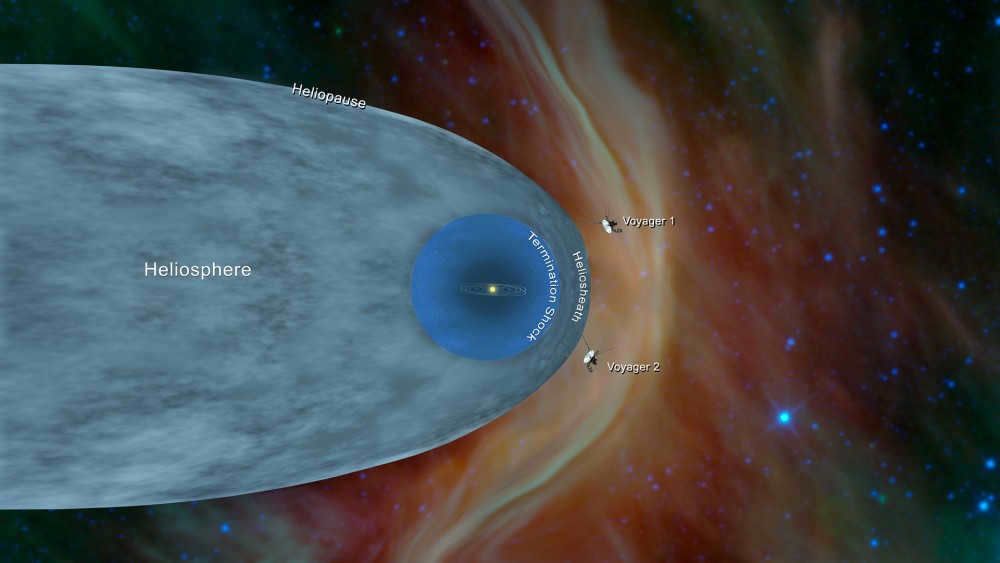
The Sun, similar to all stars, sends out a strong flow of fast particles known as stellar winds into the surrounding space. These winds originate from the upper layers of the Sun’s atmosphere and disperse in all directions, forming a bubble. As the particles travel further away from the Sun, they gradually decrease in speed until they reach subsonic speeds. The speed of sound in the interplanetary or interstellar medium is determined by the density of matter, which is approximately 100 km/s in the solar system. As a result, the kinetic energy of the stellar wind transforms into thermal energy, creating X-ray-emitting plasma with a temperature of 10^6 K. This inner layer of the bubble is referred to as the terminal shock wave. In the solar system, the size of this layer ranges from 75 to 90 astronomical units (a.u.).
The stellar wind then undergoes expansion and interacts with the interstellar medium until its velocity reaches zero as a result of this interaction. This outer layer of the bubble is known as the astropause (referred to as the heliopause in the case of the Sun).
In addition to the bubble formed by the stellar wind, there exists a region surrounding the star where the motion of charged particles is influenced by its magnetic field. This region is called the star’s magnetosphere. According to current theories, the magnetic field of a star or planet is generated by the dynamo effect, wherein rotating conductive matter with convection can sustain the magnetic field for a considerable amount of time in astronomical terms. The Sun, Earth, Mercury, and Jupiter’s moons are believed to possess magnetic fields (and corresponding magnetospheres) as a result of this phenomenon.
The collective term for the upper layers of a star’s atmosphere, its stellar wind bubble, and its magnetosphere is known as the astrosphere (referred to as the heliosphere in the case of the Sun). This expansive structure typically spans several light-years.
Cosmologist Alexander Dessler coined the term “heliosphere” in 1967. The heliospheric bubble, which is continuously supplied by the solar wind, serves as a protective barrier for the entire solar system against interstellar ionizing radiation. As the Solar System orbits around the center of the Milky Way and interacts with the interstellar medium, its heliosphere takes on an elongated shape resembling that of a comet – it is mostly spherical on one side and features a long “heliotail” on the other. Voyager 1 ventured beyond the heliopause in 2012, followed by Voyager 2 in 2018, and both spacecraft are currently situated in interstellar space.
Absolute magnitude of stars
Adaptive and active optics
Reflectivity
Astronomical unit
Baryonic acoustic oscillations
Dying star formed from a red giant
Rapid capture of neutrons
Groups of stars in a galaxy
Region surrounding a galaxy
Satellites of Jupiter discovered by Galileo
Region of space influenced by the Sun’s solar wind
Balance of forces in a celestial body
Boundary beyond which nothing can escape
Distortion of light by gravity
Force that attracts objects towards each other
Diagram showing the relationship between star brightness and temperature
Observation that galaxies are moving away from each other
Stars that are obscured by another celestial object
Highly luminous star
Faint glow of sunlight scattered by interplanetary dust
Region of the Earth’s upper atmosphere
Highly energetic and distant celestial object
Comet’s glowing cloud
Dark and cool failed star
Speed of a celestial object through space
Energetic particles from outer space
Small and dim star
Highly magnetized neutron star
Gas and dust between stars
Group of galaxies including the Milky Way
Clouds of gas and dust where stars form
Subatomic particle with no electric charge
Collapsed core of a massive star
Galaxy with irregular shape
Newly formed star
Apparent shift in position of a star due to Earth’s orbit
Measurement of distance in astronomy
Celestial body that orbits a star
Cloud of gas and dust surrounding a dying star
Phenomenon caused by solar particles entering Earth’s atmosphere
Heating of a moon caused by tidal forces
Disk of gas and dust around a young star
Region of high-energy particles trapped by a planet’s magnetic field
Group of stars that appear scattered across the sky
Leftover radiation from the early universe
Type of supernova caused by the explosion of a white dwarf
Type of supernova caused by the collapse of a massive star
Brightness of a celestial object
Force that holds atomic nuclei together
Force involved in radioactive decay
Range of wavelengths of electromagnetic radiation
Celestial objects with known and consistent brightness
Unseen matter that is thought to make up the majority of the universe
Mysterious force causing the expansion of the universe
Areas of shadow and partial shadow during an eclipse
Explanation for the origin of the universe
Celestial object beyond Neptune
Outer layer of the Sun’s atmosphere
Variable stars used to measure distances in space
Theoretical tunnels connecting different parts of space
Regions of space with extremely strong gravitational pull
Clusters of old stars in a galaxy
Gaps in asteroid belts
Measure of how elongated an orbit is
Interaction between electric fields and magnetic fields
Galaxy with a smooth and rounded shape
Change in wavelength of light due to motion
Galaxy clusters are organized into families, forming a Supercluster structure. Within this structure, there is a Local Supercluster which includes the Local Group and the Virgo Cluster. The center of mass of this Local Supercluster is situated in the Virgo Cluster. Another supergroup is located in the constellation Hercules, approximately 700 million light years away. These superclusters are separated by vast empty regions, creating a sponge-like structure in the Universe.
Key attributes of galaxies within the Local Group

The Milky Way galaxy
The Milky Way, which is our galaxy, is made up of 100 billion stars. It is composed of four spiral arms, as well as stars, gas, and dust. The stars are densely packed within 1000 light years from the center of the Galaxy. In the center of the Galaxy, there exists a mysterious source of immense energy, possibly a black hole. The Galaxy is in a state of rotation, with the inner regions spinning at a faster rate than the outer regions. Surrounding the disk of the Galaxy is an invisible halo cloud of matter.
Approximately 9/10 of the Milky Way galaxy is undetectable. The Large and Small Magellanic Clouds, which are our neighboring galaxies, are drawn towards and eventually absorbed by the invisible halo of the Milky Way Galaxy.
Characteristics of the Milky Way Galaxy

* Stars that are farther away from the center of the Galaxy have longer periods of rotation, while those that are closer have shorter periods. The central region of the Galaxy rotates in unison like a solid object.
The components of the Galaxy
? – represents the average distance of the objects in the component from the galactic plane, measured in kiloparsecs (kpc); T denotes the age of the stars included in the component, measured in years; M represents the mass of the component as a percentage of the total mass of the Galaxy; N is the estimated total number of objects in the component.
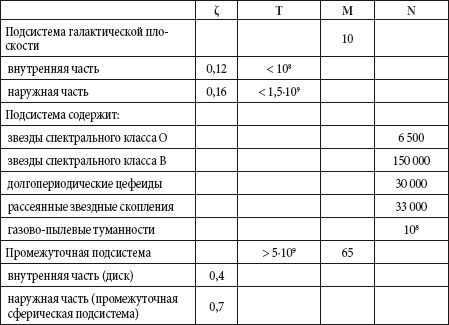

The elliptical shape and size of the Galaxy’s nucleus is approximately 4.8 ? 3.1 kpc, containing a staggering number of stars at around 3-E10 7 .
Within the central core of the Galaxy, the shape remains elliptical with dimensions of roughly 15 ? 30 pc. It houses a significant number of stars, estimated to be around 3-E10 6 .
The diameter of the Galactic nucleus is approximately 1 ps. At its center, there is a compact object, known as a black hole, with a mass of 108-09 solar masses.
Star clusters, which are relatively close groups of stars, can be categorized into two types:
– Scattered clusters have diameters ranging from 1.5 to 15 ps. They have ages that vary from several million to several billion years, and contain a number of stars ranging from several tens to several thousands. These clusters belong to the galactic plane subsystem.
– Globular clusters have diameters ranging from 15 to 200 ps. They have an age of 8-10 billion years and contain a number of stars ranging from 10 5 to 10 7 . These clusters belong to the intermediate and extreme spherical subsystems.
The total number of stars in the Galaxy is estimated to be around 1.2-10 11 .
This passage serves as an introduction to the topic.
More to Explore
Exploring the Wonders of the Milky Way
Have you ever wondered about the mysteries of the Milky Way? This celestial phenomenon, resembling a breathtaking string of precious gems, has captivated the hearts and minds of humanity since ancient times. Join us on a journey to unravel the secrets of this cosmic beauty.
What does the term “Local Group of Galaxies” mean?
The concept of a Local Group of Galaxies refers to a cluster of approximately 30-40 galaxies, including our own Milky Way as well as the Andromeda Nebula galaxy. Astronomers have determined that the farthest galaxy within the Local Group is located a significant distance away from the Sun.
GALAXIES 2: THE LOCAL GROUP
GALAXIES 2: THE LOCAL GROUP consists of a variety of galaxies, spanning a wide range of sizes. Some are dwarf galaxies, significantly smaller in size compared to our own Milky Way, while others are giant galaxies, exceeding the dimensions of our home galaxy. Our Sun, along with countless other stars, resides within the vast expanse of the Milky Way, a galaxy with a diameter surpassing 100,000 units.
GALAXIES 3: CLUSTERS AND SUPERCLUSTERS
Galaxies 3: Clusters and Superclusters A majority of galaxies are part of a cluster in some form. In the constellation Virgo, which is the closest galaxy cluster to our Local Group, there are more than 3000 galaxies. This cluster can be observed as an irregularly shaped spot.
MILKY WAY
Milky Way The Sun is just one of the countless billions of stars that exist within the Milky Way, a spiral galaxy with a diameter of approximately 100,000 light-years. The Sun is situated within one of the arms of this spiral galaxy. The galaxy itself undergoes rotation, completing a full revolution in approximately 240 million years. This
GALACTICA
GALACTICA stood out even among other military bands in St. Petersburg during the late 60s. They were known for their exceptional professional level, advanced technical equipment, and their ability to replicate Western hits with remarkable accuracy. In fact, GALACTICA was considered one of the most successful bands in the world at that time.
What is the origin of the Milky Way?
How did the Milky Way come into existence? In order to avoid Hera’s jealousy, Alcmene brought the newborn Heracles to the field beneath the walls of Thebes. It was then that Athena, under Zeus’s influence, subtly suggested to Hera to take a stroll in that very field. “Look, my dear! What a stunning and powerful child!” exclaimed Hera, seemingly unaware of her true intentions.

